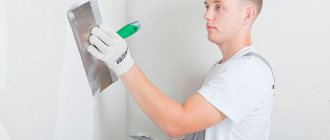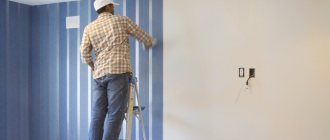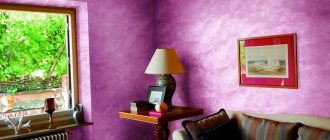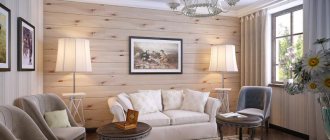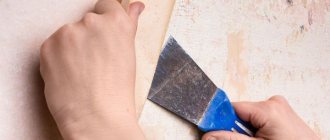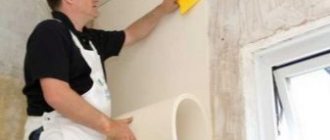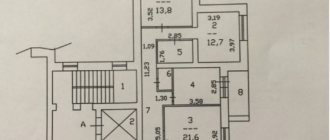We're already in the twenty-first century, and wallpaper is still one of the most popular materials for wall decoration. Of course, this is due to their affordable cost and simple installation. Meanwhile, the service life of wallpaper sometimes does not stand up to criticism: it peels off the wall, bursts, and becomes moldy. Don’t rush to blame the manufacturer for this - you simply forgot that the walls need to be properly prepared for wallpapering (you can learn more about this in the article “Preparing walls for wallpapering: step-by-step instructions”). One of the key stages is leveling, which is achieved through the use of putty compounds. What putty is best for walls under wallpaper? We talk in detail about all the nuances of choice and offer 5 excellent options that definitely won’t let you down.
- The importance of alignment;
- Various types of putty;
- Dry or ready-made option;
- 5 great options on the market;
- Useful tips for proper puttying;
- Video for better clarity;
- Conclusion.
The Importance of Alignment
This is surprising, but many people sometimes sincerely ask the following 2 questions: “ why line the walls with wallpaper
?”
and “ is it necessary to prime the walls before wallpapering
?”
Let's imagine a situation where brand new wallpaper is successfully pasted on the wall - and the owners meticulously examine the result. The drawing is slightly skewed in several places, but in others it perfectly reflects the relief features of the capital surface. “ Just think, it’s completely unnoticeable
!” - the owners will say and get down to their favorite things. And soon they will start rearranging the furniture in the apartment and, pushing the chair too intensively towards the wall, will pierce the freshly pasted wallpaper. Who knew that there was a hole in this exact place, you ask. And we will answer: the owners knew, but did nothing about it.
more than 3 centimeters
, don’t expect anything good even from the most spectacular wallpaper. They will:
- fall away;
- burst;
- distort the applied drawing.
Necessary materials
Read also: Paint for walls in an apartment: overview of available types, advantages and disadvantages, useful information for choosing (Photo & Video) + Reviews
Tools for work
For puttying work you will need the following tools:
- Spatulas. Their design is the same as that of plaster ones, but the blades are thinner. It is better to use both straight and angular (profile) varieties
- Drill with mixer attachment for mixing the composition
- Container for diluting dry mixtures (a bucket or a spacious plastic basin will do)
- Construction rule. Required for significant surface curvatures
- Level to control even application
- Grouting mesh or fine sandpaper for finishing the surface
Mixer attachment for electric drill
In some cases it is worth preparing:
- rollers and brushes for work in hard-to-reach places or additional priming of surfaces
- serpyanka mesh for sealing joints between sheets of drywall
- repair composition based on quick-drying polymers for prompt repair of identified chips and major defects
A wide and clean spatula is the main tool when leveling walls
Various types of putty
Surely, you have seen putty in construction stores more than once, but you didn’t even suspect that it turns out to differ not only by belonging to one brand or another. Now you will know what's what. Here are the known types of material for leveling walls, depending on the nature of the component base and drying speed.
Plaster
- allow you to perfectly level the wall;
- dry quickly;
- Not recommended in rooms with high humidity and sources of water.
This option allows you to get a very durable surface without any hint of shrinkage. This putty is perfect for walls under wallpaper, but only if the room in which the renovation is being carried out meets the standard humidity level.
Cement
- moisture resistance;
- severe shrinkage;
- very long drying period.
The advantage of this type of putty is that it can be used in almost any room, but due to strong shrinkage, its use is very limited.
Polymer
- are supplied ready-made;
- allow you to make the wall perfectly flat;
- in terms of density they are inferior to the gypsum alternative.
The last moment is like a fly in the ointment in a common barrel of honey. It seems that polymer compounds are ideal for use in any situation. However, due to the characteristics of the base material - often acrylic - they are more suitable for preparing walls for painting. In addition, when choosing, you should also be guided by one more point - what function the putty will perform:
- starting leveling
- used only if there are serious defects on the wall, suitable for wallpaper only when used as the first layer; - finishing
- as a rule, it has good strength of the composition and ideal whiteness, applied on top of the starting layer; - universal
- the use of this type is limited to cases where there are no noticeable flaws; it is more expensive than the options discussed above.
Why do you need to putty the walls before wallpapering?
Most modern wallpapers are glued end-to-end, because of this, any unevenness of the wall surface will be noticeable on the canvas and the seam will stand out strongly. This can be avoided by first preparing the wall, that is, covering it with putty.
Additionally, the building material performs other functions:
- increasing the strength of the base;
- improving the adhesive properties of the material with which the walls are covered;
- reducing the ability of the material to absorb moisture, which saves glue and eliminates the possibility of fungal infection;
- color alignment.
Important
If you plan to stick wallpaper on the walls, the surfaces are first primed with resin-based compounds. This creates an additional layer that protects against moisture.
Dry or ready-made option?
Another problem that may await you in the store. What putty is best to use for walls under wallpaper? Dry or ready-made option?
Experts unanimously say that it is better to prefer the first option of putty. The arguments are extremely transparent: dry putty is perfect for interior work, while the ready-made version is used mainly for exterior work. It’s also worth paying attention to a couple more points:
- does not shrink at all or not so severely;
- requires compliance with cooking rules;
- can be stored for a long time.
It is not possible to purchase ready-made versions of putty for future use - their shelf life is limited. They also give noticeable shrinkage, which is generally unacceptable when used as wallpaper. Add to this the decent cost - and your choice will be obvious!
Preparatory stage
Read also: Latex paint or acrylic: what is the difference and which one is better to choose for different types of work (Photo & Video) + Reviews
A properly diluted dry mixture is homogeneous in consistency.
When using a ready-made composition, the step of mixing the putty is skipped, and for dry mixtures proceed as follows:
- 2.5 liters of clean water are poured into a 7-liter container.
- Gradually pour the mixture into the water in a thin stream until a mound forms above the surface of the water.
- Put a mixer attachment on the drill and quickly mix the mixture until it has a homogeneous consistency without lumps. It is recommended to stir for at least 2-3 minutes
- The composition is allowed to stand for 30–60 seconds and a second batch is made. After this, the putty is ready for application.
If, when stirring, the mixture turns out to be thick or liquid, it is not recommended to add either dry material or water. It is best to knead a new portion, taking into account previous mistakes.
The preparatory stage also includes the processing of construction tools: the spatula blade is wiped with a clean, lint-free material, the buckets are washed and wiped dry.
Lumps from previously used mixtures are removed from the mixer attachment. If this is not done, future work with the new composition will be greatly complicated.
The walls to be treated are cleaned of the remnants of previous finishing: wallpaper, paint, plaster.
Useful tips for correct puttying
It is not enough to choose a putty suitable for use under wallpaper - it is also important to know how to use it correctly. Failure to comply with many points threatens to disrupt the process of preparing the wall for gluing - and the result will cause polar emotions instead of satisfaction. Therefore, pay attention to the information:
- if your walls are full of unevenness, cracks and other defects, then follow the following sequence: starting putty - priming - final putty - final priming;
- do not take long breaks while leveling the walls: a maximum of five minutes between moving from one wall to another;
- putty is scooped out of the container with a small spatula and placed on a wide one - you need to lean it perpendicular to the wall and apply a layer of the required thickness to the wall;
- They begin to putty the walls from the corner, while observing the horizontal direction.
Calculation of the amount of putty
Read also: TOP 8 Best ceiling paints: priority on reliability and durability. Review of the most popular manufacturers
Calculation of the amount of material is done taking into account the area of the working room
The amount of dry leveling mixture for treating a room is calculated according to the following parameters:
- room area minus door and window openings
- primer consumption (usually indicated by the manufacturer on the packaging)
- number of layers (minimum 3: 1 starting and 2 finishing)
- application thickness (calculated for each layer)
- stock (10–15% of the result obtained)
So, to level the vertical planes of a standard room 5 by 6 meters, with ceilings 2.8 m high, two windows and a doorway, according to average calculations, you will need 5 bags of dry mixture (25 kg each).
Required Tools
Before starting work on leveling the walls, you should find out what tools you will need:
- spatulas of several sizes: wide (40-50 cm) and small, as well as an angular option;
- a drill with a special attachment for preparing a putty mixture;
- brushes and rollers for priming walls;
- metal rule for leveling the starting layer;
- building level - helps to control the correct verticals of the walls;
- sandpaper or mesh for grouting transitions and bumps;
- containers or buckets for mixing the solution.
Step-by-step instructions for putty
Read also: Making a dressing room with your own hands: how to equip a storage system in a closet or bedroom? | 100+ Photos & Videos
Preparatory priming of walls before leveling
The leveling process using a special compound is divided into 2 stages:
- Rough finishing or starting putty. This is the name given to the first layer of the applied composition with a thickness of 0.3–0.5 cm. This step accounts for the maximum consumption of the putty mixture: all holes, cracks, and chips are filled
- Finishing or final coat. Its thickness is no more than 10–20 mm and gives the final smoothness
Before rough application, it is worth carrying out one more stage, which can no longer be called preparatory. We are talking about priming the surface: this step is needed to eliminate chips, deep cracks, and gouges.
For interior work in residential premises, acrylic and perchlorovinyl primer solutions are used. They do not have a specific odor and dry quickly (from 1 to 5 hours).
After treating the surface with a primer and drying it completely, mix the mixture or take the ready-made composition and start puttingty.
Rough application
The composition is scooped up with a small spatula and spread over the wall with a wide one.
The first layer of leveling compound is applied as follows:
- Take a small amount of putty from the container onto a small spatula.
- The composition is transferred to the middle of the blade of a wide spatula
- The tool is carefully applied to the wall at an angle of 45 degrees (from the corner of the room) and with confident smoothing movements from side to side, the composition 3 mm thick is evenly distributed over the surface
- The processing is carried out with an overlap: each next layer partially overlaps the previous one
- Take a new portion of the mixture and repeat the steps, moving to the opposite corner of the room until the entire vertical plane has been worked out
- The corners of the room are worked out with a profile spatula. The movements in this case are made up and down, and not to the sides.
- The result obtained is checked according to the construction rules, by running it over a wet surface. This not only controls the uniformity of application, but also removes excess solution
- While the surface is dry, the wall is rubbed down: manually with a fine abrasive or with a professional sanding machine. Grouting is carried out in a circular motion counterclockwise
Untreated pits and cracks are not allowed on the surface. Professionals advise to check the surface by illuminating it at close range in order to identify all possible flaws.
Finishing layer
Finishing layer grouting stage
The finishing layer is thinner (15–20 mm) and is applied in the same way as the starting layer, but with some features:
- Before starting work, several multidirectional sources of artificial lighting are installed opposite the area being treated.
- Layers are applied from bottom to top from the window (or corner of the room) to the door
- After applying the first finishing layer, the wall is allowed to dry. The surface is then cleaned again
- Grouting of the finished base is done using a fine suede nozzle.
- The final stage is re-priming with two layers. After this, the perfectly flat wall is ready for hanging even the thinnest wallpaper.
Deformed joints
Even a smooth surface can present unpleasant surprises after wallpapering. We are talking about “opened” joints.
Defective batches of wallpaper are quite rare. Therefore, deformed joints are most often a result of non-compliance with the technology of gluing panels and improper preparation of the surface of walls and ceilings.
The glue on the edges of the sheets already located at the gluing site dries faster than in the center. In combination with the high hygroscopicity of the putty layer, this causes rejection of the edges of the canvases.
The absorbent characteristics of the putty can be improved by using a two-layer coating with deep penetration primers.
Another way is to generously lubricate the joints of the sheets with wallpaper glue.
